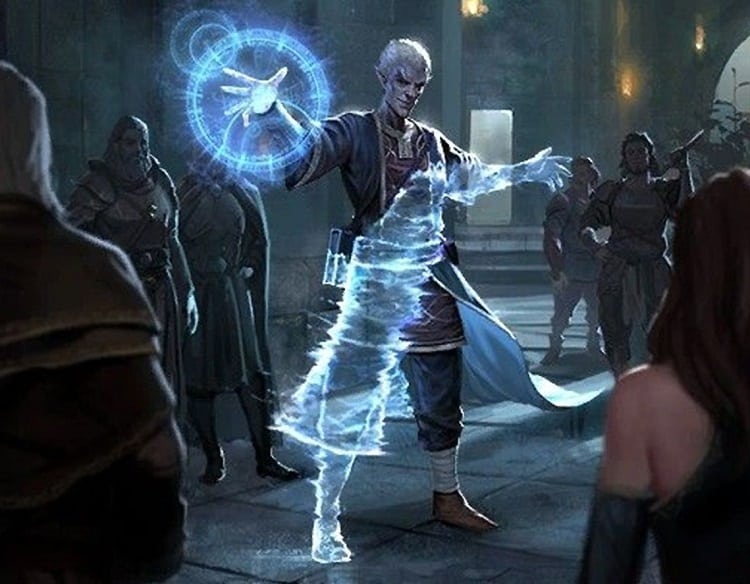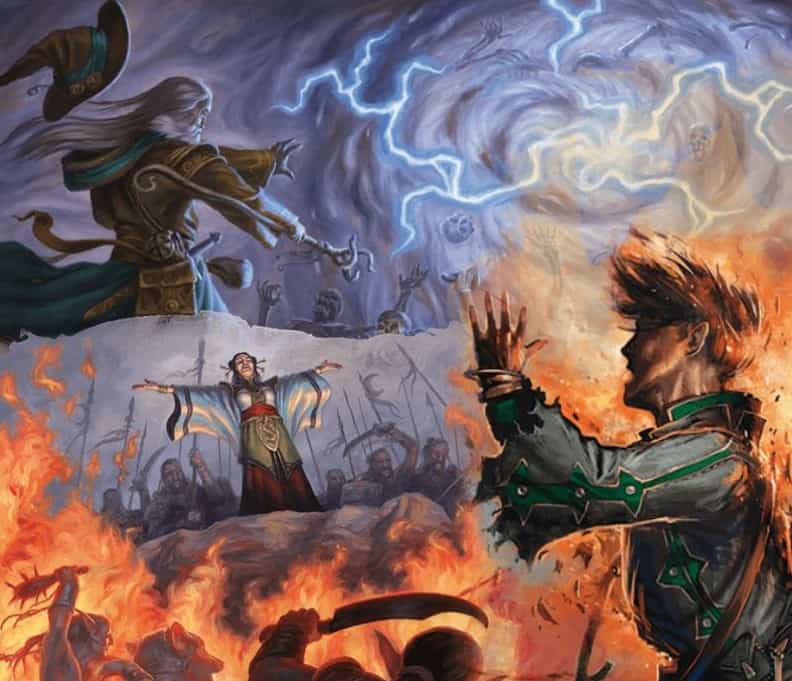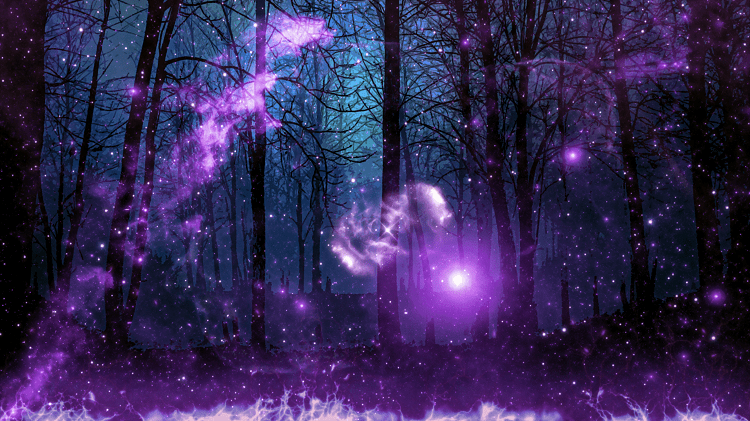Much like the sacred flame 5e spell, this is another fire-like spell that isn’t all about lighting things on fire. Faerie Fire has a lot of uses and can be a lifesaver against certain types of foes, plus there’s a lot of room for flavor when it comes to how the spell looks and affects others.
But how do you use this type of spell? What creatures is it the best against? How do you flavor it for your character? Read our Faerie Fire 5e guide and your questions will be answered.
What Is Faerie Fire Spell?
According to the Player’s Handbook, here is what the spell is all about:
- Faerie Fire
- 1st level evocation
- Casting Time: 1 action
- Range: 60 feet
- Components: V
- Duration: Up to 1 minute with concentration
- Classes: Bard, Druid
Each object in a 20-foot cube within range is outlined in blue, green, or violet light (your choice). Any creature in the area when the spell is cast is also outlined in light if it fails a Dexterity saving throw. For the duration, objects and affected creatures shed dim light in a 10-foot radius. Any attack roll against an affected creature or object has an advantage if the attacker can see it, and the affected creature or object can’t benefit from being invisible.
Let’s break this spell down. First, it takes an action to cast in a 60-foot radius and only requires a vocal component. It can last up to one minute but must be concentrated on, so you can’t cast another concentration-requiring spell or take damage without a constitution saving throw to maintain concentration.
Bards and Druids can cast this 1st level evocation spell, and when they do they outline a 20-foot cube. Anything inside of this cube is outlined in blue, green, or violet light. If creatures are inside of this radius then they must make a dexterity saving throw or be outlined in the light. Creatures shine for a 10-foot radius, attacks against them have an advantage, and the creature cannot turn invisible.
Basically, faerie fire outlines creatures and objects with light to make them easier to see and hit. While this might seem like a free advantage on an attack roll and nothing more, there are a few other tricks that this spell allows its caster to do. For one thing, the spell lasts for 1 minute or 10 rounds of 6 seconds per round combat, so that’s 10 rounds of advantage on a target!
If you are fighting a huge enemy with massive amounts of AC and a large hit point pool, those extra ten rounds might be all you need to cut through the AC and whittle down the enemy. Especially if your Fighter or Paladin has a multi-attack skill.
But there is one area where the spell really shines, and that is against invisibility.
How Invisibility Works In 5e

Invisibility is one of those spells that is great when you can use it, but it sucks whenever your enemies get to use it and you can’t counter it. Characters and anything they are carrying becomes invisible to the naked eye, but it always drops if you attack or cast a spell. Still, invisible characters have an advantage on their first attacks, have disadvantages on attacks made against them, and damage does not make the creature fully visible.
There’s also Greater Invisibility, which doesn’t end whenever attacks are made or spells are cast. Instead, it just lasts the full minute (10 rounds of combat) which can make combat against foes much harder due to the disadvantage attacking invisible creatures brings. No one likes to shadow a box for ten rounds while the invisible foe runs rings around you.
Invisible Stalkers, giant chameleons, pixies, certain demons, and other undead can become invisible in the base game. Plus, any creature can be edited to become invisible if you just change a few stats around, so if you want your characters to encounter invisible creatures they will do so.
The advantage for the first attack, especially if it is a surprise round and it can be a very devastating first round for a party. In order to counter invisibility and greater invisibility, fairie fire can be used.
Using Faerie Fire To Counter Invisibility
You can detect invisible creatures, even if you can’t see them, often through sound or smell. Using fairie fire on an area where you suspect an invisible creature to be can help illuminate them and they lose all the benefits of being invisible. You can also use the spell during combat on areas as well, illuminating any invisible creatures who might be lurking in the shadows.
Granted, most of these monsters have at least average dexterity modifiers, but if you level up and increase your spell save DC, you can counter them. This can help you turn the tide during larger battles against invisible foes, making the fight more even. Since it’s a first-level spell, you can also keep casting it at higher levels until it works.
Once you can see them, you can hit them, and if you can hit them then combat becomes a breeze afterward! There’s no reason not to have this spell if you are fighting invisible creatures.
Using Fairie Fire Against Darkness
While most of the races in the game either have dark vision or darkness spells that allow them to create light or at the very least a torch, in some cases you might be in an area where the usual ways of producing light don’t work. Faerie fire doesn’t just illuminate objects and creatures to give you an advantage; it also causes them to produce dim light in a ten-foot radius.

This dim light can be enough to counter the dark, so even pieces of furniture or debris can function as lanterns and makeshift light sources as you battle to get back to the light. In most cases, you will have the ability to make light, but fairie fire is a spell that is great to have in your back pocket just in case you find yourself in too dark of an area.
How To Flavor Faerie Fire?
If you are the type of player who wants to do more than saying ‘I cast faerie fire’, then you can do a lot to the flavor and roleplay the spell. For starters, even though the official description says that the light needs to be blue, green, or violet… you can talk to your DM to make it any color you want. Maybe your character has a favorite color or a color that is important to them, and since the change is cosmetic most DMs will not object.
Since there’s only a vocal component to the spell, you can also say whatever you want for the casting of Faerie Fire. Depending on your character, you can say whatever makes sense and then have them throw out the cube of color.
Druids might even flavor the fairie fire as not light at all, but rather a moss or other glowing lichen or item that is thrown out and covers all the enemies. There’s a lot that you can do with it, so don’t be afraid to try.
Using Faerie Fire Defensively
Of course, this spell doesn’t just need to be offensive with countering invisibility or giving you an advantage against your foes, but it can also be used in a defensive role as well. Everyone inside of the cube needs to make a dexterity save, and that includes your allies. If you have your high AC paladin and fighter fail the save (as they can either roll poorly or just choose to fail) then they have an advantage applied to them.
Enemies will more than likely leave the squisher opponents alone and start attacking the high AC and high health tanks of the group. This allows your bards, druids, and wizards to attack from range, and your tanks should be able to weather the blows.
Of course, you will want to talk about this strategy with your teammates first, because nothing is more shocking than getting faerie fire cast on you while surrounded by enemies! You also should be careful where you cast it because remembering that everyone needs to make that dexterity save certainly changes things.

Does Faerie Fire Scale Well?
In most cases, the 1st level spells are quickly grown out of whenever the higher-level spells are available to get. They might be good for smaller moments, but typically first-level spells are rarely used during the larger battles. Except for Faerie fire, which is pretty good at all levels.
For one thing, it negates invisibility, gives your characters an advantage on all attacks, lasts for 10 rounds, and only has one saving throw. The prospect of a guaranteed advantage can always be useful, especially against the larger monsters you will be fighting later on in the game. 10 turns can be plenty when it comes to slaying them!
Plus, it only costs a first level spell slot so it can be used a lot at higher levels and still gives the same benefits without needing to use higher-level spell slots. It’s a good spell that most players will be casting until the end of the game.
Faerie Fire FAQ
Question: How Does Faerie Fire Look To The Party?
Answer: Faerie Fire is actually a coating of light that causes targets to be illuminated, so it isn’t really fired at all. You could think of it as a ‘faerie light’ and can roleplay it effectively. Faerie Fire is also used by the Drow as they gained the ability from the Faezress inside of the Underdark, and they would use it in combat as well as for decoration.
For your character, if you get the idea of shooting fire out of your hands out of your head, and instead think of it like a cube of light that outlines everything it is easier to roleplay. For your character, you can also make stylistic changes. Characters from other books that can use the spell, such as Artificers, can use the spell in a different way.
Maybe instead of light, this tech-oriented hero can expose the enemies’ weaknesses using steampunk-style tech. Drow might use shadowy hands that cling to enemies and expose them, and a bard might cover affected targets in musical notes.
Question: What About Objects Affected By The Spells?
Answer: Of course, it’s not just the creatures and hostiles inside of the area that is affected by the light, but all of the objects as well. This can include furniture, chests, weapon racks, debris, and any object that isn’t held by a creature. They all automatically fail their Dexterity save and start emitting light in a 10-foot radius. You also get an advantage while attacking those objects.
This can be perfect if you want to break down a door, break open a chest, or attack these objects for other reasons. While most objects in 5e tend to have low AC and hit points depending on what they are made out of, a little extra advantage never hurt at all.
If you need to destroy an object as part of a quest, however, faerie fire can be very helpful with that.
Question: Should I Use Faerie Fire As Part of A Performance?
Answer: If your bard is very flamboyant and driven when it comes to being a bard, they might decide to use faerie fire to enhance performance, especially at night. It can turn objects into light sources, outline performers at night so they are easy to see, and can just be a splash of color that can dazzle people.
It can be used as s social spell as well. It doesn’t do any harm other than outline things in light for a minute. Maybe you could trick someone into thinking they are protected by a shield spell, or that a mundane item is magical because of the Faerie Fire ‘Aura’ around it. With a little persuasion work, you could have some fun social interactions with the spell!
- DnD Demons Guide: What Are Demons in 5e? - September 18, 2021
- Detect Thoughts 5e Guide: When, Why and How to Use It - September 9, 2021
- The Ultimate DnD Toll the Dead 5e Guide - September 9, 2021

